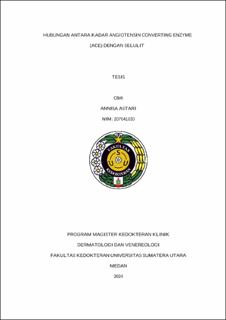Hubungan antara Kadar Angiotensin Converting Enzyme (ACE) dengan Selulit
Relationship between Angiotensin Converting Enzyme (ACE) and Cellulite

Date
2024Author
Astari, Annisa
Advisor(s)
Putra, Imam Budi
Jusuf, Nelva Karmila
Metadata
Show full item recordAbstract
Background: Cellulite is a local metabolic disorder in subcutaneous tissue
characterized by changes in skin topography, occurring in parts of the body with a
large accumulation of fat tissue, especially thighs, buttocks, hips, and abdomen.
Angiotensin converting enzyme is a zinc metallopeptidase, distributed on the
surface of endothelial cells. Increased ACE levels cause microcirculation disorders,
adipocyte hypertrophy, increased extracellular matrix, and stimulate the emergence
of inflammatory cytokines which will cause an increase in the inflammatory
response in the tissue, stimulate fibrogenic response and influences the appearance
of cellulite.
Objective: To determine the relationship between ACE levels and cellulite.
Subjects and Methods: This research was an observational analytical study with
a cross-sectional design, involving 40 cellulite patients and 40 control who meet
inclusion and exclusion criteria. Each patient underwent anamnesis and
dermatological examination. Then take blood samples to assess ACE levels using
the ELISA test. These data were analyzed statistically using the Chi square test.
Results: In this study, it was found that the highest age group who experienced
cellulite was 42,5% aged 26–35 years. Most of them have a family history of
cellulite, 55% of mothers. The majority of locations where cellulite occurs are in
the femoral and gluteus regions, 67,5%. The mean ACE level in cellulite was
66,7815,38 μg/ml. The results showed that there was a relationship between high
ACE levels causing 4,5 times risk of cellulite (p=0.002).
Conclusion: There is a relationship between high ACE levels causing cellulite.
